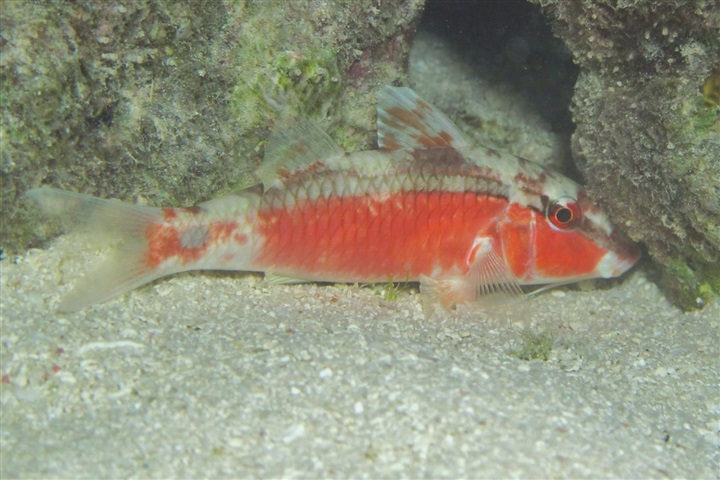Parupeneus macronemus


| Latin name | Parupeneus macronemus - (Lacepède, 1801) |
|---|---|
| Local name | Long-barbel goatfish |
| Family | Mullidae - Parupeneus |
| Origin | East Indian Ocean, West Indian Ocean, Australia, The Red Sea, Indonesia, Central/West Pacific |
| Max length | 40 cm (15.7") |
| Minimum volume |
900 l (237 gal) |
|---|---|
| Hardiness |
Average |
| Suitable for aquarium |
Experience, preparation and extra care required |
| Reef safe |
Reef safe with caution |
| Aggressiveness | Docile |
| Recommended |
Fish Larger crustaceans (Shrimp, crabs...) Other invertebrates Small crustaceans (Krill, mysis, artemia...) Zooplankton (Cyclops, pods...) |
|---|
This species is known to jump out of open aquaria.
This species can be a threat for small fishes, crustaceans, worms, snails etc.
This fish requires feeding several times a day, especially when newly added.
When the fish can find its natural food in the aquarium it requires less frequent feeding.
This species needs good hiding places, for example, between live rocks.
This species revels in swimming and requires an aquarium with ample space.
This species is very shy and docile, so one should be careful when keeping it with more aggressive fish.
Goatfish (Mullidae) have a very characteristic "beard" which they use when searching the sand for food. The aquarium should therefore have a large open area with both sand and coral gravel for example.
These fish are not particularly well suited to aquaria as they often die after a few months due to malnutrition.
To succeed with these fish, one must feed them a varied diet 4-5 times a day, this in addition, to them finding their own food in the aquarium.
It can be difficult to fulfil their dietry needs, as they quickly consume the natural food in the tank and the amount of feeding places a large strain on the aquarium.
They require a large amount of food when young, but less when fully grown.
Goatfish are considered predators, as they will eat small fish and crustaceans.
| Aquarium trade | Yes |
|---|---|
| Distribution | Indo-West Pacific: Red Sea and Persian Gulf south to Natal, South Africa extending east to Indonesia and the Philippines. Record from Hawaiii is an error. |
| French common names |
Rouget à longs barbillons Surmulet à bandes noires Capucin à longs barbillons |
| English common names |
Long-barbeled goatfish Long-barbel goatfish Longbarbel goatfish |
| German common names |
Kurztreifenmeerbarbe |
| Danish common names |
Langskægget mulle |
Scott W. Michael. 2004. Angelfishes and Butterflyfishes (Reef Fishes Series Book 3) TFH Publications / Microcosm Ltd. - (English)
Bob Fenner. Mulling Over the Goatfishes, Family Mullidae, Part I - Wet Web Media - (English)
Bob Fenner. Mulling Over the Goatfishes, Family Mullidae, Part II - Wet Web Media - (English)
Bob Fenner. Mulling Over the Goatfishes, Family Mullidae, Part III - Wet Web Media - (English)
Bob Fenner. Goatfishes in Indonesia, Family Mullidae - Wet Web Media - (English)

